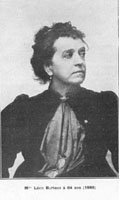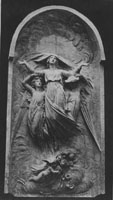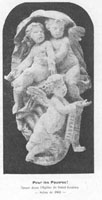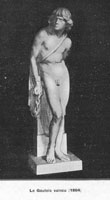Working
the System: Hélène Bertaux and Second Empire Patronage
by Anastasia Easterday
 |
The Second Empire (1852-70) served as the point of convergence for the first substantive wave of women sculptors in France. In his Dictionnaire des Sculpteurs de l'Ecole Française au XIXe Siècle (1914-1921), Stanislas Lami included at least thirteen women whose careers either encompassed or began sometime during the Second Empire.1 More still appeared in salon guides and reviews. While most of the women active at this time received only the briefest critical attention, a small number stood out as major artistic figures: Marguerite Dubois d'Avesnes, among the first to address the lacuna of sculpture instruction for women, taught several students including Charlotte Besnard, who in turn debuted in 1869 and went on to launch a successful career during the Third Republic. The widowed Marie Lefèvre-Deumier was able to work her way into the imperial household to become an unofficial portraitist, somewhat akin to the role also played for a time by the more widely recognized Jean-Baptiste Carpeaux.2 More prominent still were Noémie Constant, known as "Claude Vignon," and the celebrated Duchesse de Castiglione Colonna, who exhibited under the name "Marcello." Almost completely unknown today, Hélène Bertaux seems to have enjoyed the greatest professional standing of her female colleagues during the 19th-century (fig. 1). Launching her career in relative obscurity at the beginning of the Second Empire, her initial success was due not only to her considerable technical competence, but also to her strategic appeals for support as a woman artist. She particularly sought out government officials and others with close ties to the imperial household, whose support represented an important mark of official distinction that opened the doors to other opportunities.
Born in 1825, the daughter of a minor ornamental sculptor, Bertaux began working in her father's studio at the age of fifteen. Her formative training, first under her father, and later with Augustin Dumont, provided her with a technical competence and competitive edge unusual for a woman at that time.3 Conforming to a conservative (academic) ideal, her work appealed to a wide market of both public and private patrons. She enjoyed an extensive exhibition record including several awards, such as a gold medal from the 1889 Universal Exposition, and the hors concours designation (meaning that her work was not subject to jury approval for the annual Salon exhibitions). Her name figured prominently in the press, including numerous exhibition reviews in well-circulating journals such as the Gazette des Beaux-Arts, and L'Art Français. In addition to her professional pursuits as an artist, Bertaux instituted the Union of Women Painters, Sculptors and Engravers in 1881 to provide both successful and emerging women artists with a forum in which to expose their work. As president of the Union for many years, she was also editor of its monthly journal. A vocal champion of women's professional artistic advancement, she established the first sculpture school for women, set up several monetary awards for women artists, and became a dominant force in the crusade to force the Ecole des Beaux-arts to open its doors to them. Towards the end of her life, after a long campaign to get women onto the salon jury, she was finally elected in 1896 as the first (and only) woman to serve until her death in 1910.
Well aware of the path towards success as she began her professional life, Bertaux sought access to elite patronage through numerous letters of solicitation. A particular series of letters from her requesting the state purchase of an early relief of The Assumption of the Virgin, offers insight into her strategies. Going directly to the top, she addressed herself to the Superintendent of Fine Arts Emilien de Nieuwerkerke, to the Emperor Napoleon III, and perhaps also to his cousin the Princess Mathilde. Perceptive and persistent, she gauged her audience and submitted her request accordingly. Appealing to empathy, paternalism and discernment, in each case she called attention to her unusual position as a woman facing the difficulties of succeeding in a male dominated profession. While it took years from her first letter in 1859 to the eventual purchase of the relief in 1868, in the meantime, she became well-known within the art bureaucracy, receiving other lucrative commissions that helped to launch and eventually sustain her career.
 |
Bertaux began soliciting the government for support around 1859 when she made her Assumption relief on speculation. Not long after, in 1861, the state made its first purchase of her work-not the relief, but rather a holy water basin depicting The Three Theological Virtues in the guise of cherubs, and an elaborate collection box entitled For the Poor!. For the latter, the state paid 6,000 francs, a very generous sum for such a small-scale sculpture.4 Both pieces ended up in the church at Saint Gratien, near the summer ch‰teau of the Emperor's cousin, the Princess Mathilde.
While the Emperor shied away from direct involvement in the arts administration, his cousin Mathilde, an artist herself, seems to have played an indirect but powerful role. Following her separation from an abusive husband, she befriended Count Emilien de Nieuwerkerke and made him into her protégé. In a position to further his career, she pressed for his appointment as Director-General of Museums in 1849, and used her influence to secure his subsequent promotions and awards, including his election into the Academy of Fine Arts, his induction into the Legion of Honor, and his appointment in 1863 as Superintendent of Fine Arts, a post especially created for him by the Emperor.5 It is likely that Bertaux knew of Mathilde's connection to the Superintendent, and tried to ingratiate herself to both. While it is impossible to determine who became her greatest ally, both seemed favorably disposed towards encouraging women artists in general, and it was during Nieuwerkerke's tenure that the state eventually purchased the Assumption.
 |
Although there is no direct evidence linking Bertaux and Mathilde, in an undated letter from among the records maintained by the art bureaucracy, and very likely written after the early 1861 acquisitions, Bertaux asked an unnamed "Madame" to use her influence to persuade the administration to purchase her relief of the Assumption. This anonymous person to whom Bertaux had addressed her request would almost certainly have been Mathilde, since no other woman at the time held any substantial influence over the art bureaucracy. Lacking as it was in extreme formality, the letter probably could not have been intended for the Empress, who was also supportive of women artists, but usually remained fairly removed from administrative matters.
Encouraged by the acquisitions for Saint Gratien, Bertaux had sent a second appeal earlier in 1861 to the Minister of State to purchase her relief. Despite the fact that her request was accompanied by signatures of support from several government deputies, she received no response. Following this rebuff she wrote her letter to the unnamed woman:
Madame, encouraged by those familiar with the nobility of your character, I dare, for the first time in my life, address myself to one so distinguished, in order to speak the language of an artist hardly established in the world.Whether or not Bertaux was able to have an audience with Mathilde (or to whomever the letter was intended) is impossible to say. That the letter was forwarded to the proper bureaucrats indicates that someone had at least taken an interest in her situation "as a woman, wife, and mother" whose "normal hardships" made success elusive. In any case, despite Bertaux's bold attempt, the state did not immediately acquire her Assumption. For that it took several more years and several more letters, to the Emperor, (though it was undoubtedly intercepted by the art administration before it ever reached his eyes), and later to Nieuwerkerke. Like her initial letter to the Minister of State, these had signed endorsements from deputies and other officials scribbled along the margins. The relief had already been exhibited, receiving an honorable mention in 1863, and Bertaux had since received medals for other work. Enumerating these proven qualifications in her 1867 letter of solicitation to Napoleon III, she asked him for a commission in bronze:For several years my name has figured in the sculpture section in the guide to the salon, where I had the honor at the last exhibition to see my work purchased by His Majesty the Emperor. Encouraged…I then worked on an Assumption…[T]he work, seen in my atelier by distinguished individuals, was judged by them worthy of acquisition for the church of Bessuire…[T]his request, signed by the most eminent names was addressed six months ago to the Minister of State. What has become of it I do not know. It was then Madame, that the thought came to me to summon your benevolent regard to me. See me as a woman, a wife and mother…who wants to triumph in her position…
If you deign, Madame, to turn your eyes towards me, to personally order a report from one of the inspectors regarding the merit of the work, if the report is favorable, and finally, by happy chance, [if] a work in marble or in stone would be entrusted to me by his excellence the Minister, I would owe you all my [illegible word] Madame, and fulfilled in my lofty obligations, I will acquire a name among the great religious sculptors-a place quite difficult to attain, a woman's normal hardship making very difficult the lasting fears, the long months, during which a free arm must take up the chisel in order to produce a work…
If I dared to finish here with a request, I would entreat you, Madame, to consent to grant me the favor of an audience in which I could properly tell you how much I am glad as a woman that I was spared from making my request to these gentlemen whom I no longer know.6
Madame Léon Bertaux, statuaire, begs your Majesty to kindly grant the favor of a purchase of a large bas relief, in a unique bronze version … representing the Assumption of the Virgin …[T]he qualifications that she dares to put forward in order to appeal to the kindness of your Majesty, are: the difficulties that she met, as a woman, to share in official commissions; her exhibitions, uninterrupted for ten years; and two medals that were awarded to her by the jury for the salons of 1864 and 1867.She begs your Majesty to kindly grant a favorable regard to this request, to encourage her future, the whole of which is destined to that of a sculptor.
She has the honor to be, with the most profound respect to your Majesty, your very humble and loyal subject.7
 |
[Y]ou are, sir, my natural protector. It is therefore to you alone in this circumstance that I once again place my destiny.
The Emperor has dedicated his life to the improvement of the working class; you have dedicated yours to the happiness and prosperity of the arts and the artists the most deserving due to their talent…
…[I] am a woman, and because of that reason official commissions are lacking despite two medals. For ten years there have only been the acquisitions which I owe to your goodness; the two groups for Saint-Gratien and the young Gaul. I would like to pay my debt of gratitude through merit, and thus I must work very hard, and our [type of] work is expensive.8
In 1868 Bertaux's relief was finally acquired for 4,000 francs and soon followed by other commissions. Considering her substantial professional success even before the purchase of her relief, it seems strange that she would have pressed her case so adamantly. In addition to the several official acquisitions and her Tuileries commission, she had also received a commission in 1865 from the city of Paris for statues of Saint Philip and Saint Mathew for the church of St. Laurent, as well as one in 1868 for a pediment relief of The Pascal Lamb for the entrance of the church of St. Francis Xavior. However, Bertaux was neither independently wealthy nor a dilettante. Working without outside resources, she was trying to secure an income that would allow her to maintain a large workshop as well as support an upper-bourgeois way of life. She did not want the odd handouts or awards given to minor sculptors, but rather the steady and major commissions necessary to sustain a serious professional career. These were difficult to come by, as Bertaux pointed out, especially for a woman for whom patronage was seen more as a favor than as her due.
References:
1. Stanislas Lami, Dictionnaire des Sculpteurs de l'Ecole Française au XIXe Siécle, (Paris: H. Champion, 1914-1921).
2. Anne Wagner, Jean-Baptiste Carpeaux: Sculptor of the Second Empire, (New Haven: Yale University Press, 1986), pp. 175-207.
3. For biographical information see Lami, pp. 108-111; and Edouard Lepage, Une Page de l'Histoire de l'Art du XIXe Siécle: Une Conquête Féministe, Mme Léon Bertaux, (Paris: J. Dangon, 1912).
4. Dosier Achat, Groupe en Bronze, (carton F/21/118), Archives Nationales, Paris.
5. For a somewhat sensational account of Mathilde's life and social milieu, see Joanna Richardson, Princess Mathilde, (London: C. Tinling and Co., 1969). For a discussion of Nieuwerkerke within the context of the Second Empire, see Patricia Mainardi, Art and Politics of the Second Empire: The Universal Expositions of 1855 and 1867, (New Haven: Yale University Press, 1987), pp.35-36.
6. Letter from Bertaux to an unnamed "Madame," undated (ca. 1861), from Dossier Bertaux, (carton F/21/118), Archives Nationales, Paris. See also letter from Bertaux to the Ministre d'Etat, 17 May 1861 from the same dossier.
7. Letter from Bertaux to Napoleon III, ca. June 1867, from Dossier Achat: bas-relief en bronze: l'Assomption, (carton F/21/118), Archives Nationales, Paris.
8. Ibid.
© 2000 Part and Anastasia Easterday. All Rights Reserved.